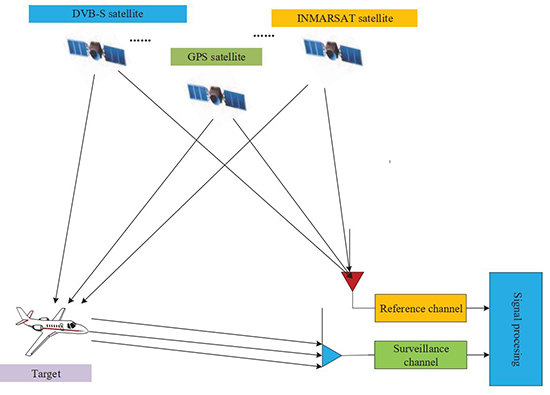Using Heterogeneous Satellites for Passive Detection of Moving Aerial Target
Abstract
1. Introduction
- For signal purification, parallel band-pass filters are employed to separate the direct wave signals in the reference channel. Moreover, an adaptive filter based on normalized least mean square (NLMS) is applied to suppress direct-path interference (DPI) and multi-path interference (MPI) in the surveillance channel.
- The maximum value of the cross ambiguity function (CAF) and the fourth order cyclic cumulants cross ambiguity function (FOCCCAF) of each separated direct wave signal and the echo signal are used to improve the signal-to-noise ratio (SNR) of moving aerial target detection.
- Detection results are obtained by fusing the decisions of multiple sensors to enhance the reliability of moving aerial target detection.
2. System Model
3. Interference Suppression
3.1. Direct Wave Signal Separation in the Reference Channel
3.2. DPI and MPI Suppression Based on NLMS Adaptive Filter
4. Detection Statistics Construction
4.1. Detection Statistic Construction Based on CAF
4.2. Detection Statistic Construction Based on FOCCCAF
4.3. Detector Design
| Algorithm 1 The procedure of the proposed passive detection method. |
5. Moving Aerial Target Detection Performance Analysis
5.1. Performance Analysis of Detection Based on CAF
5.2. Performance Analysis of Detection Based on FOCCCAF
6. Numerical Results and Discussion
7. Conclusions
Author Contributions
Funding
Conflicts of Interest
Appendix A
Appendix A.1. Proof of Lemma 1
Appendix A.2. Proof of Lemma 2
References
- Hashim, I.; Al-Hourani, A.; Rowe, W.; Scott, J. Adaptive X-Band Satellite Antenna for Internet-of-Things (IoT) over Satellite Applications. In Proceedings of the 13th International Conference on Signal Processing and Communication Systems, Surfers Paradise, Australia, 16–18 December 2019; pp. 1–7. [Google Scholar]
- Li, F.; Lam, K.; Zhao, N.; Liu, X.; Zhao, K.; Wang, L. Spectrum Trading for Satellite Communication Systems with Dynamic Bargaining. IEEE Trans. Commun. 2018, 66, 4680–4693. [Google Scholar] [CrossRef]
- Ilyushin, Y.; Padokhin, A.; Smolov, V. Global Navigational Satellite System Phase Altimetry of the Sea Level: Systematic Bias Effect Caused by Sea Surface Waves. In Proceedings of the 2019 PhotonIcs & Electromagnetics Research Symposium—Spring (PIERS-Spring), Rome, Italy, 17–20 June 2019; pp. 1618–1627. [Google Scholar]
- Qiao, J.; Chen, W.; Ji, S.; Weng, D. Accurate and Rapid Broadcast Ephemerides for Beidou-Maneuvered Satellites. Remote. Sens. 2019, 11, 787. [Google Scholar] [CrossRef]
- Powell, S.; Akos, D. GNSS Reflectrometry Using the L5 and E5a Signals for Remote Sensing Applications. In Proceedings of the 2013 US National Committee of URSI National Radio Science Meeting, Boulder, CO, USA, 9–12 January 2013; p. 1. [Google Scholar]
- Clarizia, M.; Chotiros, N.; Vaccaro, M. A GPS-Reflectometry Simulator for Target Detection Over Oceans. In Proceedings of the IGARSS 2018–2018 IEEE International Geoscience and Remote Sensing Symposium, Valencia, Spain, 23–27 July 2018; pp. 450–451. [Google Scholar]
- Garvanov, I.; Kabakchiev, C.; Behar, V.; Garvanova, M. Target Detection Using a GPS Forward-Scattering Radar. In Proceedings of the 2015 International Conference on Engineering and Telecommunication, Mosocw, Russia, 18–19 November 2015; pp. 29–33. [Google Scholar]
- Clarizia, M.; Braca, P.; Ruf, C.S.; Willett, P. Target Detection Using GPS Signals of Opportunity. In Proceedings of the 2015 18th International Conference on Information Fusion, Washington, DC, USA, 6–9 July 2015; pp. 1429–1436. [Google Scholar]
- Gronowski, K.; Samczynski, P.; Stasiak, K.; Kulpa, K. First, Results of Air Target Detection Using Single Channel Passive Radar Utilizing GPS Illumination. In Proceedings of the 2019 IEEE Radar Conference, Boston, MA, USA, 22–26 April 2019; pp. 1–6. [Google Scholar]
- Mojarrabi, B.; Homer, J.; Kubik, K. Power Budget Study for Passive Target Detection and Imaging Using Secondary Applications of GPS Signals in Bistatic Radar Systems. In Proceedings of the IEEE International Geoscience and Remote Sensing Symposium, Toronto, ON, Canada, 24–28 June 2002; pp. 449–451. [Google Scholar]
- Zeng, H.; Chen, J.; Wang, P.; Yang, W.; Liu, W. 2D Coherent Integration Processing and Detecting of Aircrafts Using GNSS-Based Passive Radar. Remote. Sens. 2018, 10, 1164. [Google Scholar] [CrossRef]
- AlJewari, Y.; Ahmad, R.; AlRawi, A. Impact of Multipath Interference and Change of Velocity on the Reliability and Precision of GPS. In Proceedings of the 2014 2nd International Conference on Electronic Design, Penang, Malaysia, 19–21 August 2014; pp. 427–430. [Google Scholar]
- Wu, X.; Gong, P.; Zhou, J.; Liu, Z. The Applied Research on Anti-multipath Interference GPS Signal Based on Narrow-related. In Proceedings of the 2014 IEEE 5th International Conference on Software Engineering and Service Science, Beijing, China, 27–29 June 2014; pp. 771–774. [Google Scholar]
- Suberviola, I.; Mayordomo, I.; Mendizabal, J. Experimental Results of Air Target Detection with a GPS Forward-Scattering Radar. IEEE Geosci. Remote Sens. Lett. 2011, 9, 47–51. [Google Scholar] [CrossRef]
- Lashley, M.; Bevly, D.; Hung, J. Performance Analysis of Vector Tracking Algorithms for Weak GPS Signals in High Dynamics. IEEE J. Sel. Top. Signal Process. 2009, 3, 661–673. [Google Scholar] [CrossRef]
- Liu, M.; Gao, Z.; Chen, Y.; Song, H.; Li, Y.; Gong, F. Passive Detection of Moving Aerial Target Based on Multiple Collaborative GPS Satellites. Remote. Sens. 2020, 12, 263. [Google Scholar] [CrossRef]
- Liu, M.; Yi, F.; Liu, P.; Li, B. Cramer-Rao Lower Bounds of TDOA and FDOA Estimation Based on Satellite Signals. In Proceedings of the 2018 14th IEEE International Conference on Signal Processing, Beijing, China, 12–16 August 2018; pp. 1–4. [Google Scholar]
- Masjedi, S.; Moddares-Hashemi, M. Theoretical Approach for Target Detectionand Interference Cancellation in Passive Radar. IET Radar Sonar Navig. 2013, 7, 205–216. [Google Scholar] [CrossRef]
- Zhang, Y.; Xi, S. Application of New LMS Adaptive Filtering Algorithm with Variable Step Size in Adaptive Echo Cancellation. In Proceedings of the 2017 IEEE 17th International Conference on Communication Technology, Chengdu, China, 27–30 October 2017; pp. 1715–1719. [Google Scholar]
- Niranjan, D.; Ashwini, B. Noise Cancellation in Musical Signals Using Adaptive Filtering Algorithms. In Proceedings of the 2017 International Conference on Innovative Mechanisms for Industry Applications, Bangalore, India, 21–23 February 2017; pp. 82–86. [Google Scholar]
- Mugdha, A.; Rawnaque, F.; Ahmed, M. A Study of Recursive Least Squares (RLS) Adaptive Filter Algorithm in Noise Removal from ECG Signals. In Proceedings of the 2015 International Conference on Informatics, Electronics Vision, Fukuoka, Japan, 15–18 June 2015; pp. 1–6. [Google Scholar]
- Cardinali, R.; Colone, F.; Ferretti, C.; Lombardo, P. Comparison of Clutter and Multipath Cancellation Techniques for passive Radar. In Proceedings of the 2007 IEEE Radar Conference, Boston, MA, USA, 17–20 April 2007; pp. 469–474. [Google Scholar]
- Liu, M.; Zhang, J.; Li, B. Feasibility Analysis of OFDM/OQAM Signals as Illuminator of Opportunity for Passive Detection. In Proceedings of the 2018 14th IEEE International Conference on Signal Processing, Beijing, China, 12–16 August 2018; pp. 1–4. [Google Scholar]
- Hong, J.; Wang, S.X.; Lu, H.J. An Effective Direction Estimation Algorithm in Multipath Environment Based on Fourth-order Cyclic Cumulants. In Proceedings of the IEEE 5th Workshop on Signal Processing Advances in Wireless Communications, Lisbon, Portugal, 11–14 July 2004; pp. 263–267. [Google Scholar]
- Yan, X.; Wang, S.; Wang, K.; Jiang, H. Localization of Near field Cyclostationary Source Based on Fourth-order Cyclic Cumulant. In Proceedings of the 2008 9th International Conference on Signal Processing, Beijing, China, 26–29 October 2008; pp. 1629–1632. [Google Scholar]
- Jun, H. A proper integral representation of Marcum Q-Function. In Proceedings of the 2014 XXXIth URSI General Assembly and Scientific Symposium, Beijing, China, 16–23 August 2014; pp. 1–3. [Google Scholar]
- Bocus, M.; Dettmann, C.; Coon, J. An Approximation of the First Order Marcum Q-Function with Application to Network Connectivity Analysis. IEEE Commun. Lett. 2013, 17, 499–502. [Google Scholar] [CrossRef]
- Ermolova, N.; Tirkkonen, O. Laplace Transform of Product of Generalized Marcum Q, Bessel I, and Power Functions With Applications. IEEE Trans. Signal Process. 2014, 62, 2938–2944. [Google Scholar]
- Hu, B.; Liu, M.; Yi, F.; Song, H.; Jiang, F.; Gong, F.; Zhao, N. DOA Robust Estimation of Echo Signals Based on Deep Learning Networks with Multiple Type Illuminators of Opportunity. IEEE Access 2020, 8, 14809–14819. [Google Scholar] [CrossRef]
- Liu, M.; Zhang, J.; Tang, J.; Jiang, F.; Liu, P.; Gong, F.; Zhao, N. 2D DOA Robust Estimation of Echo Signals Based on Multiple Satellites Passive Radar in the Presence of Alpha Stable Distribution Noise. IEEE Access 2019, 7, 2169–3536. [Google Scholar]
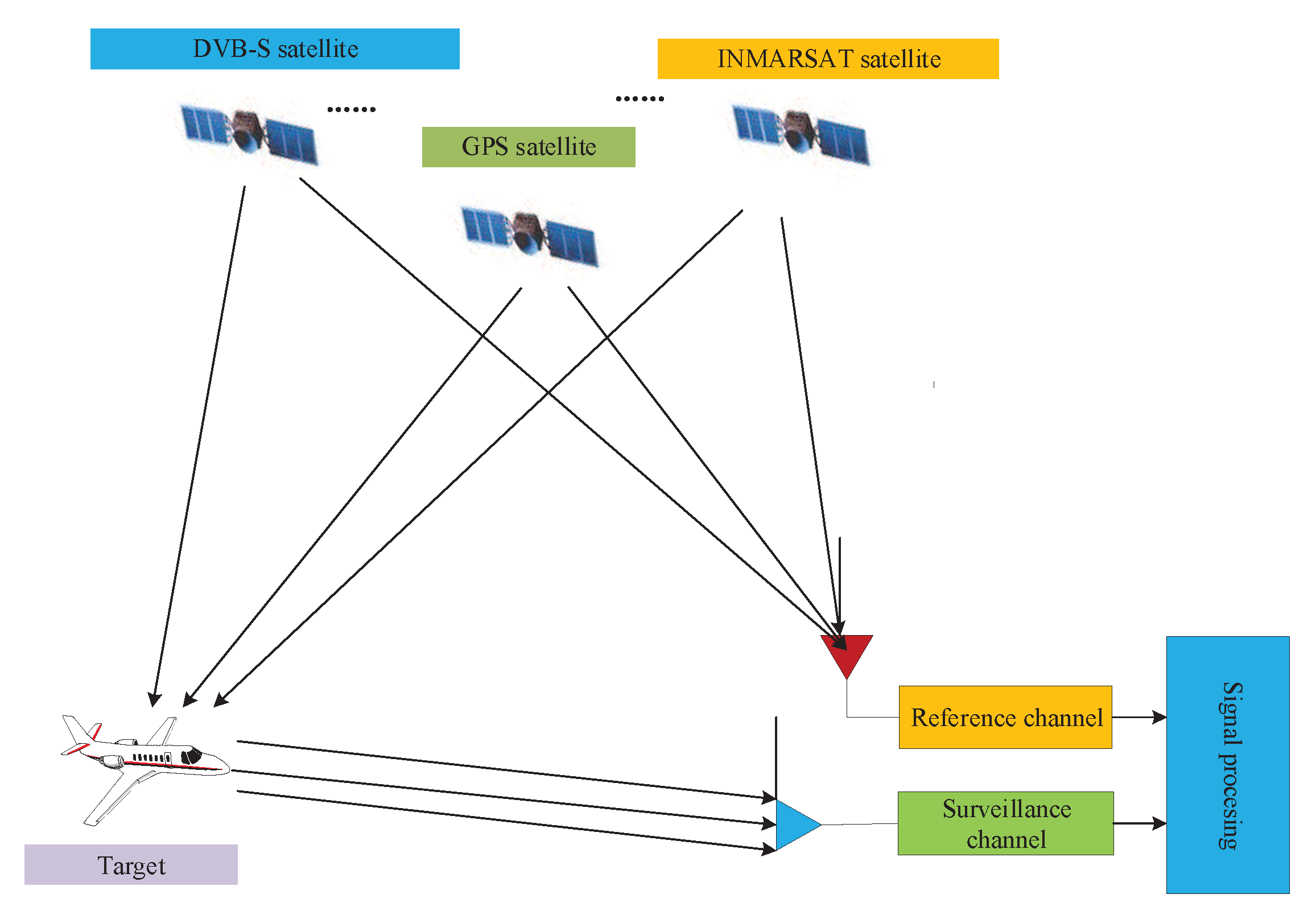

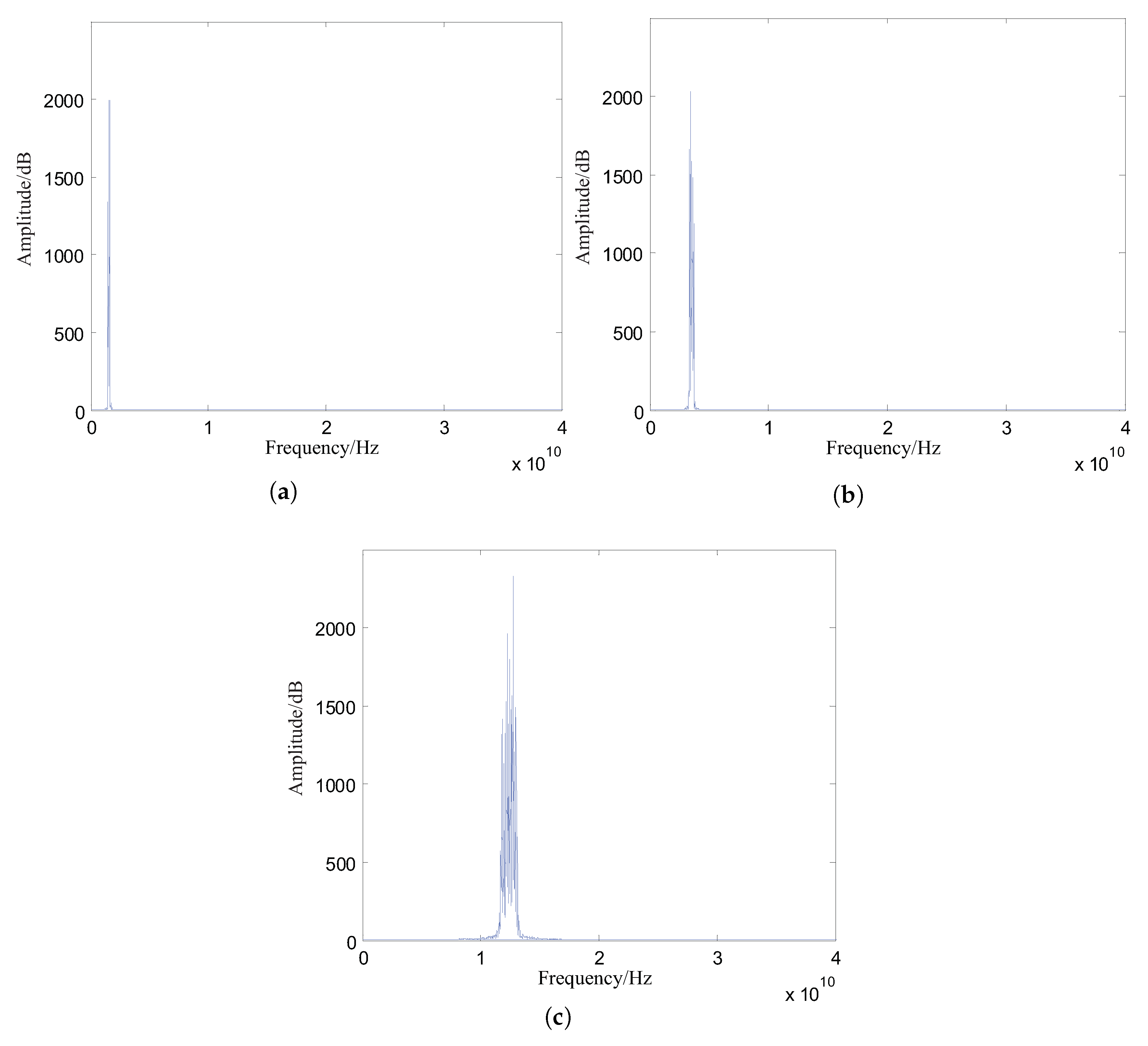


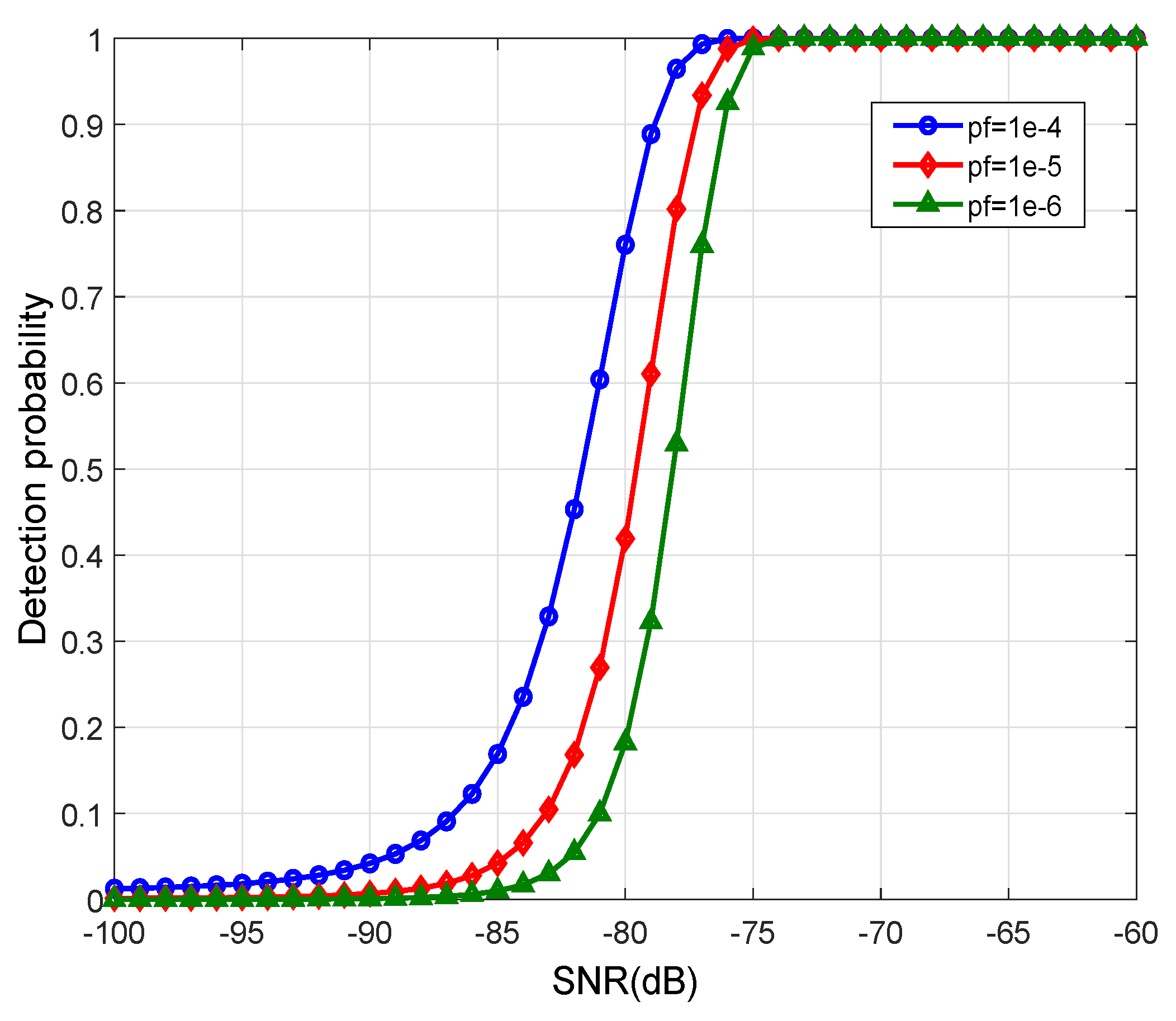
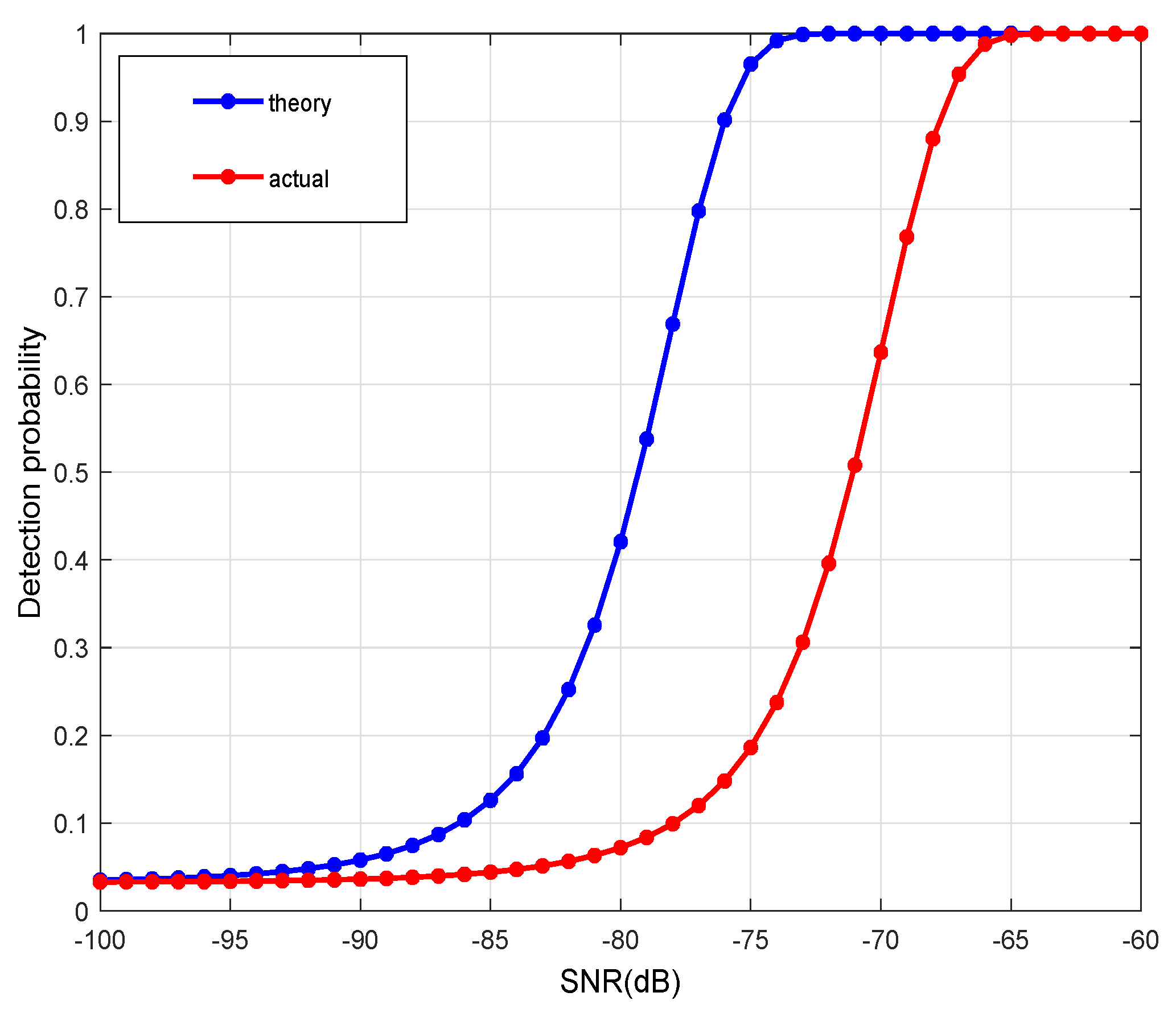

© 2020 by the authors. Licensee MDPI, Basel, Switzerland. This article is an open access article distributed under the terms and conditions of the Creative Commons Attribution (CC BY) license (http://creativecommons.org/licenses/by/4.0/).
Share and Cite
Liu, M.; Li, K.; Song, H.; Chen, Y.; Gao, X.; Gong, F. Using Heterogeneous Satellites for Passive Detection of Moving Aerial Target. Remote Sens. 2020, 12, 1150. https://doi.org/10.3390/rs12071150
Liu M, Li K, Song H, Chen Y, Gao X, Gong F. Using Heterogeneous Satellites for Passive Detection of Moving Aerial Target. Remote Sensing. 2020; 12(7):1150. https://doi.org/10.3390/rs12071150
Chicago/Turabian StyleLiu, Mingqian, Kunming Li, Hao Song, Yunfei Chen, Xiuhui Gao, and Fengkui Gong. 2020. "Using Heterogeneous Satellites for Passive Detection of Moving Aerial Target" Remote Sensing 12, no. 7: 1150. https://doi.org/10.3390/rs12071150
APA StyleLiu, M., Li, K., Song, H., Chen, Y., Gao, X., & Gong, F. (2020). Using Heterogeneous Satellites for Passive Detection of Moving Aerial Target. Remote Sensing, 12(7), 1150. https://doi.org/10.3390/rs12071150






